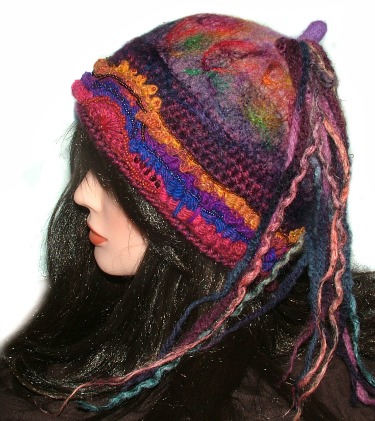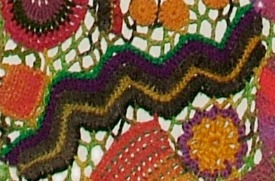This post contains affiliate links.
Today I’m pleased to feature an interview with Renate Kirkpatrick, the fiber artist, teacher, and author living in the Sunshine Coast in Queensland, Australia, as my 100th blog post! I first discovered Renate’s work through the Tunisian Crochet group on Ravelry. The moderators posted the names of several Tunisian crochet books on the group page, and I saw Renate’s Crochet Techniques listed. I decided to take a chance and order it on Amazon since the description sounded delightful. (You can read my review of the book as part of my comparative review of the 20+ crochet stitch guides in my collection here.) Since then, I’ve seen more of Renate’s work on her blog, her Flickr photostream, her Facebook page, and her Ravelry designer page. I particularly love her recent pictures of her crocheted metallic vest on Flickr.
The Interview

Underground Crafter (UC): How did you first learn to crochet?
Renate: To be honest, I really don’t remember… I do recall, as a child, sitting with a neighbour as she crocheted slippers and how thrilled I was when she gave me my very own pair… perhaps something subliminal going on there. My grandmother and great grandmother were both wonderful crocheters/knitters, and I have a box filled with their beautiful works that I treasure, but I never knew them so perhaps there’s a bit of genetics going on too. I think I made my first granny square in my mid-teens. (UC comment: I also treasure my grandmother’s beautiful work, some of which you can see in this post.)

(UC comment: For more info about the Beanie Festival, an event where Aboriginal and non-Aboriginal artists share their work and culture together, visit the website here.)
UC: What inspired you to start designing?
Renate: Family, friends, students… Family members and friends would ask me to make this or that and I’d write it down as I went so not to forget. Students asking for more than just sampler squares. The sheer challenge of coming up with a pattern idea and writing it down.

UC: I recently bought a copy of Bring Colour to Crochet: 64 Multi-Coloured Squares. What was the design process like for this book? How did that compare to the process for your other two books?
Renate: My first two books, Freeform Crochet and Beyond: Bags, Cushions, Hats, Scarves and More (Milner Craft Series) and Crochet Techniques
, came about through tragedy. The local craft shop where I was teaching was destroyed by fire, along with all my sampler rugs (afghans) and the many freeform examples I had on display. Luckily, I still had all the patterns. I put together book proposals and submitted them to a number of publishers. About 6 months later, Sally Milner Publishers contacted me for 2 books and so it began. I like to think that Bring Colour to Crochet: 64 Multi-Coloured Squares
sits somewhere between the first two. My hope is that the traditionalists and freeformers alike will be challenged and inspired by the variety of colour incorporations and also the many novel stitches that make up this 64 pattern sampler.

UC: What first inspired you to teach crochet?
Renate: The desire to help and share. I was teaching Papermaking and Hooked Rag Rugging at said local craft store when I was asked if I’d like to teach some basic crochet as well. Not one to do things by halves, I decided that once the students had a grasp of the basics they might want to try their hand at something more challenging to continue on – and so, the first sampler rug was born (Classic in Crochet Techniques). From there it was a matter of staying a step or two in front of these enthusiastic ladies and with each crochet technique explored (Tunisian, double-ended, in the round, Jacquard), a new sampler was created as a teaching tool and goal setter. (UC comment: My students keep me on my toes too, and definitely inspire me to learn new techniques and advance my skills.)
As a teacher, there is nothing more satisfying than having a student come to class lacking confidence and leaving excited and believing they can do it.
UC: Has teaching crochet impacted your own personal crafting?
Renate: Absolutely… The very fact that I was asked to teach the basics propelled me forward to research and explore. Without my students asking “What’s next?”, I would never have learnt what I know today or achieved half as much. It was a student who first introduced me to freeform, which has become my passion and the creative joy of my life.

UC: Where do you generally find your creative inspiration?
Renate: It’s always so cliché but nevertheless true, the Natural World and all that that encompasses – colour, texture, and form. What can I say? I’m an Australian; our colours are over-the-top, vivid, bright; our textures tactile; and our forms bold. It’s more than enough to keep me inspired for a very long time. I blogged about this very theme some time ago.
UC: What is your favorite crochet book in your collection (besides your own, of course)?
Renate: I think I may have more craft books and magazines than the local library, but can’t say I refer to one more than another. I do like to crawl the opportunity shops for old, old, patterns and books but so do others, or so it seems, because they’re very hard to come by now.

UC: Do you have any favorite crafting blogs or websites you’d like to share?
Renate: Ravelry is probably my most favorite site. It brings together so many different people and ideas. I’ve met so many interesting, passionate craftspeople that I feel quite at home and the mind boggles with all the exciting things happening in the yarn world.

UC: (Insert question here: Feel free to share anything that I haven’t asked about that you would like to talk about related to creativity, crochet, designing, new projects, teaching, etc.)
Renate: As I look back over the years and remember how crochet/knitting, indeed many older crafts, were considered out-dated, redundant, and doddery, I’m delighted to see their revival and the enthusiasm in which they are being embraced all ’round the world.
Lastly, and at the risk of repeating myself because I say this so often, I’m an avid believer in “the doing.” How often do you hear, “Oh, but I’m not the least bit creative…” I still maintain that everyone harbours some creativity within them and it comes to life through “the doing.” Talent is one thing but not nearly enough. Without “the doing,” how will the talent ever awaken and come to fruition? A good old Aussie saying, “You’ll never know unless you give it a go…”
Well said, Renate! Thank you so much for stopping in for an interview today. And now on to the book review…
Book Review
Since I enjoyed Crochet Techniques (Milner Craft Series) so much, I decided to pick up Renate’s Bring Colour to Crochet: 64 Multi-Coloured Squares
. (You can check out a great picture of the completed sampler here.)

The book starts with an introduction that includes illustrated stitch instructions, a stitch symbol key, and some helpful tips for weaving in ends since the patterns require frequent color changes. Renate also includes directions for edging and joining the squares in the beginning section. As with Crochet Techniques, stitch abbreviations throughout the book use Australian/UK terms with US terms in parentheses.
I use stitch samplers as a teaching tool a lot, so I really appreciate the book’s concept. Each sampler square is photographed individually and each square uses two to five colors. The squares are organized into 13 groups (Basic Stripes; Spikes; Shells: Zigzags; Reliefs; Ripples; Chains; Mosaics; Clusters and Bobbles; Afghans; Variable Stripes; Novelty Squares; and Bricks and Boxes) which makes it easier to find them later. Since the entire sampler uses the same five colors, there is a very coordinated appearance to the book. If you have several stitch guides, you may recognize some of the stitches in Renate’s squares, but often the colors are introduced to new effect. My personal favorite stitches are Square 25, 31, 32, 34, and 43.
On the other hand, if you are not fond of Renate’s color palette, you can obviously substitute yarns, but that topic isn’t specifically addressed. There isn’t any pattern difficulty rating listed, so it would be hard for someone new to crochet or pattern reading to have a sense of the comparative difficulty of the patterns. You can tell from reading the book that Renate as a teacher is relatively laid back about gauge (tension) and she suggests that you use a hook and yarn that you are comfortable with. However, I know from personal experience that when I was still relatively new to pattern reading, I had great difficulty getting my squares made from Jan Eaton’s 200 Crochet Blocks for Blankets, Throws, and Afghans: Crochet Squares to Mix and Match to be the same size. I think some beginners might need more explanation of gauge, yarn substitution, and hook sizes if they were working up a full sampler from Renate’s book without having her physically present as a teacher :).
Overall, I really like the sampler format. I found quite a few stitches that I hadn’t seen elsewhere, or which were reinvented through the use of color. I enjoyed Renate’s relaxed style compared to some books which can make me feel like the Crochet Police are looking over my shoulder. However, if you are the type of crocheter who likes to follow the pattern exactly in terms of gauge, color choices, etc., you may find that Renate is not “strict” enough for you. I recommend the book to crocheters looking for some new stitches, who enjoy making afghans and rugs, and/or who are afraid of color and would like a friendly teacher to walk them through some explorations. The book may be too challenging for most beginners to work their way through (though an adventurous beginner would have a lot of fun experimenting with the book). In my Amazon review, I gave the book 4 out of 5 stars.
The Giveaway
Today’s giveaway kicks off my week of giveaways in celebration of my 100th blog post, which you have just read! Yay!
Today’s prize is The Crochet Lite Crochet Hooks-Size I 5.5mm.
This hook is brand new in the package and includes batteries. In addition to having a comfort grip, this hook lights up, so you can work on that stitch sampler afghan in the wee hours of the night :). It has an on/off switch to protect battery life. I have never used the Crochet Lite hooks but it seems like a cool idea :).



Oh, My, I’m adore your fantastic colours, patterns and all of your things! I hope that once I will try make a cushion or a little something, a bag, for instance. But what kind of thread the best gor them? I don’t know. Thank you very much and have a nice weekend!